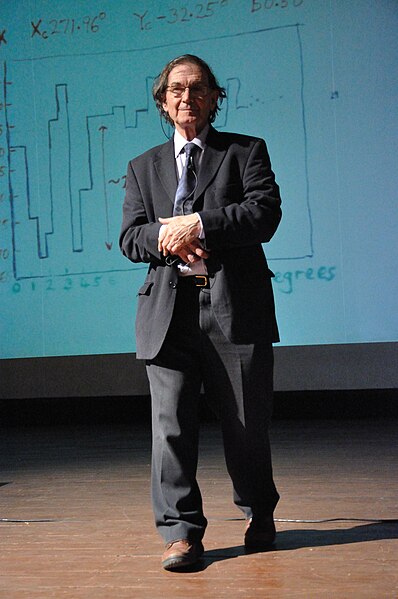Orchestrated objective reduction
Orchestrated objective reduction is a theory which postulates that consciousness originates at the quantum level inside neurons, rather than the view that it is a product of connections between neurons. The mechanism is held to be a quantum process called objective reduction that is orchestrated by cellular structures called microtubules. It is proposed that the theory may answer the hard problem of consciousness and provide a mechanism for free will. The hypothesis was first put forward in the early 1990s by Nobel laureate for physics, Roger Penrose, and anaesthesiologist Stuart Hameroff. The hypothesis combines approaches from molecular biology, neuroscience, pharmacology, philosophy, quantum information theory, and quantum gravity.
Logician Kurt Gödel
A: An axon terminal releases neurotransmitters through a synapse and are received by microtubules in a neuron's dendritic spine. B: Simulated microtubule tubulins switch states.
Image: Roger Penrose 9671
Image: Stuart Hameroff TASC2008
Consciousness, at its simplest, is awareness of internal and external existence. However, its nature has led to millennia of analyses, explanations and debate by philosophers, theologians, and scientists. Opinions differ about what exactly needs to be studied or even considered consciousness. In some explanations, it is synonymous with the mind, and at other times, an aspect of mind. In the past, it was one's "inner life", the world of introspection, of private thought, imagination and volition. Today, it often includes any kind of cognition, experience, feeling or perception. It may be awareness, awareness of awareness, or self-awareness either continuously changing or not. The disparate range of research, notions and speculations raises a curiosity about whether the right questions are being asked.
Schema of the neural processes underlying consciousness, from Christof Koch
A Buddhist monk meditating
Thomas Nagel argues that while a human might be able to imagine what it is like to be a bat by taking "the bat's point of view", it would still be impossible "to know what it is like for a bat to be a bat." (Townsend's big-eared bat pictured).
John Searle in December 2005








